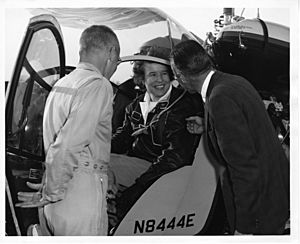Dora Dougherty Strother facts for kids
Quick facts for kids
Dora Dougherty Strother
|
|
|---|---|

Jean Dougherty Strother, with E.J. Ducayet (right) and R.C. Buyers (left)
|
|
| Born | November 27, 1921 St. Paul, Minnesota, U.S.
|
| Died | November 19, 2013 (aged 91) |
| Resting place | Arlington National Cemetery |
| Nationality | American |
| Education |
|
| Awards |
|
| Aviation career | |
| Full name | Dora Jean Dougherty Strother McKeown |
| Air force | U.S. Army Air Forces |
| Rank | Lieutenant Colonel |
Dora Jean Dougherty Strother (born November 27, 1921 – died November 19, 2013) was an amazing American pilot. She is famous for being a Woman Airforce Service Pilot (WASP). She also showed how well the huge B-29 Superfortress plane could fly.
Dora was a pilot for the U.S. military. She also worked as an engineer for Bell Aircraft. She taught at the University of Illinois. Later, she became a test pilot for helicopters. She earned a PhD in Aviation Education from New York University in 1955. She won the Amelia Earhart Award for her studies. She is also in the Military Aviation Hall of Fame. In 1987, she joined the Texas Women's Hall of Fame. Dora was also a leader in pilot groups like the Whirly-Girls and the Ninety-Nines.
Contents
Flying During World War II
In 1940, Dora earned her pilot's license. This was through a special program for civilian pilots. She then became one of the first women in the U.S. to get an airline pilot license. During World War II, many male pilots were needed for fighting. This opened up new chances for women to become pilots.
At first, there were two separate training programs for women pilots. These programs later joined together in 1943. They became the Women’s Airforce Service Pilots (WASP). Dora Strother joined the WASP program. She was part of the third group of women to train.
What WASPs Did
WASP pilots like Dora did many important jobs. They trained other pilots and pulled targets for anti-aircraft gun practice. They also flew planes from one base to another. WASPs flew almost every type of plane used by the Army Air Forces. This included training planes, cargo planes, and even fighter jets. They also helped train male pilots to fly these planes.
Flying the B-29 Superfortress
In 1944, Dora and another WASP, Dorothea Johnson Moorman, were chosen for a special task. They were picked by Lt. Col. Paul Tibbets. Their job was to learn to fly the B-29 Superfortress bomber. This plane was very large and was thought to be hard to fly. Tibbets wanted the two women to show that the B-29 was safe and easy to handle.
After just four days of training, Dora and Dorothea were certified to fly the B-29. They were among the very few women to fly this type of plane for many years. They flew a B-29 from Alabama to New Mexico. There, they took male crews on flights. They trained them and showed how easy it was to fly the B-29. This helped change the male crews' minds about the plane.
Dora Strother left the U.S. Army Air Forces on December 20, 1944. She had flown 23 different types of aircraft.
After the War: Teaching and Engineering
After the WASP program ended, Dora began teaching. She taught flying courses at the University of Illinois. Before that, from 1944 to 1949, she taught pilots and moved planes around the country. In the early 1950s, she went back to school. She earned her doctorate degree in Aviation Education in 1955. She then returned to the University of Illinois as a Chief Research Pilot.
Working with Helicopters
In 1958, Dora started working for Bell Aircraft. She was a human factors engineer. This meant she designed helicopter cockpits to be easy for pilots to use. Even though she was great at flying regular planes, Dora also became an expert at flying helicopters. She became a test pilot for Bell Helicopter.
Dora set two world records for helicopters. She flew to an altitude of 19,406 feet (about 5,915 meters). She also flew a straight line distance of 404.36 miles (about 650.78 kilometers). She set the altitude record in a Bell 47G-3 helicopter. She held these helicopter records from 1961 to 1966.
Dora Strother's Legacy
After she retired from Bell Helicopter, Dora joined the U.S. Army Science Board. She worked for Bell Helicopter/Textron for 28 years. She helped make their human factor engineering team very well-known. She was honored by three professional groups for her work.
Dora Strother also played a big part in helping WASP pilots get recognized. Her stories and efforts helped make WASP service officially count as military service. This meant that women pilots from World War II could get veteran's status and benefits. On Thanksgiving Day, November 23, 1977, President Jimmy Carter signed a law that gave WASPs military status.

